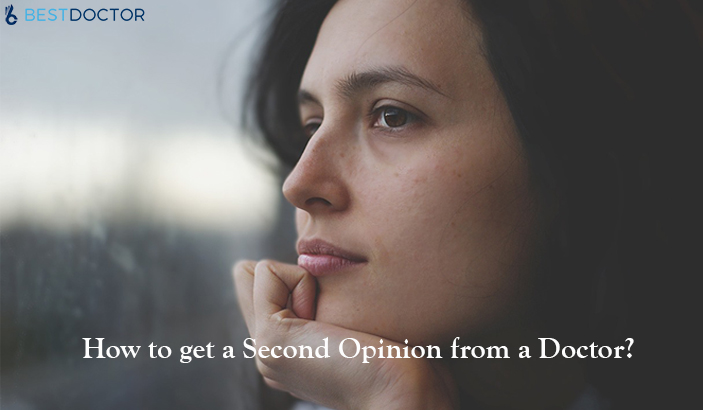The diagnosis of a fatal disease such as breast cancer, lymphoma or lung cancer always comes as a shock for patients and different patients act and respond differently to the news. But the truth is that the patient along with each and every member of his or her family wants to opt for a second medical opinion in order to confirm the diagnosis and more importantly to come to terms with the truth. But in most cases the patient feels reluctant to approach the doctor because of the fear of offending or upsetting him. It is necessary to understand the fact that most doctors encourage patients to opt for a second opinion so that the experts can discuss the case openly once the patient receives the second opinion. Dr. Gregory Abel, a blood cancer specialist at Harvard-affiliated Dana-Farber Cancer Institute says “If you have a doctor who would be offended by a second opinion, he or she is probably not the right doctor for you.”
Two Ways to Get a Second Opinion
Taking a medical second opinion does not mean you don’t trust your GP, a second opinion from a different consultant helps to confirm the diagnosis of your doctor and in case of a misdiagnosis it offers the opportunity to get back to the right path of treatment where the patient can opt for less invasive treatment options that have fewer side effects, but how to get a second opinion from a doctor? Well, there are two ways to second opinion:
In-person Second Opinions:
Beth Moore, executive vice president of program strategy for the Patient Advocate Foundation said that in-person medical second opinions are better suited for rare diseases.In this case, the diagnosis involves sophisticated tests and complicated procedures. In case the two opinions are divergent, the patient should opt for a third or even fourth opinion.
Know Your Rights:
Second opinions are the best way to know more about the diagnosis of your disease and the available treatment options. Not every doctor has the same approach to the disease – some may follow a conservative method while others may have a more aggressive approach. It is a patient’s right to choose the approach that he or she wants to opt for.
Search for Top Doctors:
In most cases the patient’s doctor recommends another specialist or physician. But if that is not the case then the patient may have to search a doctor himself. Make a list of the doctors who specialize in the particular field of medicine and then narrow down the search based on the following factors – experience, qualification, location, reliability.
Contact The Doctor You Choose and Talk Face to Face:
Once you get an appointment with the specialist, talk to him in person. You should reveal all the information about your illness and condition (records, test results, x-rays and pathology reports) so that he can understand the situation thoroughly.
It can take multiple sessions with your doctor or consultation with another unbiased physician in order to arrive at a conclusion and appropriate therapy.
Online Second-Opinion Service:
Online medical second opinion services have become increasingly popular in recent times and it has empowered the patient to a great extent. Some of the medical second opinion services are run by established medical centers such as Cleveland clinic and Massachusetts General Hospital as well as independent businesses that work with specialists.
Steps for Getting an Online Medical Second Opinion
Following is a step by step procedure for how to get a medical second opinion online. For this procedure, the physicians and specialists at the consulting firm undertake a thorough review of the patient’s medical records and diagnostic tests.
Request An Opinion:
In order to request a second medical opinion at an established medical center or independent firm the patient has to select a condition, get registered to use the site by setting up a user name and password and then fill up a medical history questionnaire.
Create A Profile:
The first time user has to fill up a registration form with his/her name, e-mail ID, contact number, etc. and create a profile. The existing users can directly log in with their used name and password.
Create a Medical Case:
Once an account is created, the patient can submit his/her medical case. It will consist of detailed information of the medical condition including present diagnosis, symptoms, current and past medications, medical records, test results and medical history.
Choose an Option:
The patient can choose a diagnosis option based on his/her medical case. If the patient is not sure about the right option then representatives of the specific site can advice the patient to opt for the standard option based on which the medical experts and specialists will be assigned to the case.
Get Second Opinion:
The patient will receive a detailed report containing suggestions, recommendations and treatment options which he/she can share with the doctor in order to ensure correct diagnosis and treatment.
Who Should Look for Medical Second Opinion Online?
• Online second opinion services are especially useful for those living far away from major medical hubs that cover a range of medicine specialties and physicians.
• It is also beneficial for employers who are offering second medical opinion as a part of employee benefits.
• It is used by insurance companies that require the client to get a second opinion for a serious procedure such as surgery.
Facts about Second Medical Opinion
Research shows that in 90% of cases, a second medical opinion reduces the risk of misdiagnosis.
It’s hard to believe but 45% of spine surgeries are found to be unnecessary when reviewed by a second medical expert.
Breast cancer is one of the most prevalent forms of cancer among women but 15% of breast cancer cases are diagnosed only following a second opinion.
Between 2 to 9% of pathology reports are identified as partially or completely incorrect upon second review.
Despite the amazing benefits of second opinion, they are less common that you think. A recent poll revealed that about 70% of Americans don’t get second opinion or do additional research.
According to some estimates, diagnostic errors occur in 10 to 15% of cases.
According to a study published in the American Journal of medicine, about 60% of the patients end up following the recommendations from the second opinion.
Seek Second Medical Opinion to Avoid a Misdiagnosis
Doctors can go wrong or make mistakes sometimes; therefore, it is always good to seek additional medical opinion, even if your insurance does not cover it, because it’s a matter of life and death.
Trisha Torrey, a patient advocate from Syracuse, New York can tell you all about it. A golf-ball-sized growth in her abdomen was misdiagnosed as a fatal tumor. The surgeon who removed it was so baffled with the case that he consulted another doctor and both agreed that Torrey had subcutaneous panniculitis-like T-cell lymphoma and she had only a few months to live. But Torrey’s other test results – blood work and CT scans did not show any evidence of cancer. She finally decided to take things into her own hands and started looking into her medical records. She discovered that some of the test results that the doctor had ordered such as the clonality test were missing. Torrey found another doctor by word of mouth who sent her test results to the National Institutes of Health and it said Torrey did not have cancer. She had panniculitis or inflammation of fat cells which the missing clonality test would have revealed.
Linda Smith, a 67-year old from New Albany, Ohio was diagnosed with a precancerous lump in her breast. She had it removed surgically and then underwent five weeks of radiology treatment. After completion of the therapy her doctors recommended that she take a chemotherapy pill. This hit the switch and she sought a second opinion through Cleveland Clinic’s MyConsult where the pathologists determined that Ms. Smith had had a different type of precancerous lump than the one originally diagnosed and therefore, there was no need for the five weeks radiology treatment. In order to resolve the conflicting opinions, she opted for a third opinion that concurred with the second opinion.
Dr. Peter Pronovost, director of the Armstrong Institute for Patient Safety and Quality at Johns Hopkins, told CNN:”It’s (Misdiagnosis) probably one of the, if not the, most under-recognized issues in patient safety… Much of the harm that we once labeled as inevitable we’re now seeing as preventable.”
A second opinion provides peace of mind to the patient and his/her family members, helps to confirm a diagnosis or rectify a misdiagnosis and offers alternative treatment options. So, don’t hesitate if you are contemplating a second opinion. Your doctor won’t be upset if you want to be better informed about your condition. Most doctors welcome the inputs from another unbiased physician.A second review often helps to identify information that was missed or misinterpreted the first time.
[cl-review quote=”Medically Reviewed By” author=”Dr. Kaushal M. Bhavsar (MBBS, MD)” occupation=”Assistant Professor in Pulmonary Medicine, GMERS Medical College, Ahmedabad” avatar_image=”1325″ source=”url:https%3A%2F%2Fwww.linkedin.com%2Fin%2Fdr-kaushal-bhavsar-a8137355%2F|target:_blank”]










Enhancing Your Career Opportunities with Improved Vision from LASIK Surgery in Manhattan
What Does Cloudy Urine Mean in Females and Males?
Palmar Hyperhidrosis: Understanding Causes, Symptoms, and Treatment
16 Warning Signs You Need to Go See Your Doctor As Early As Possible